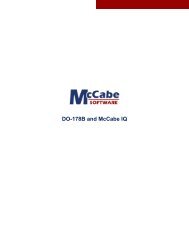Structured Testing - McCabe and Associates
Structured Testing - McCabe and Associates
Structured Testing - McCabe and Associates
You also want an ePaper? Increase the reach of your titles
YUMPU automatically turns print PDFs into web optimized ePapers that Google loves.
Considering a set of several paths gives a matrix in which the columns correspond to edges<br />
<strong>and</strong> the rows correspond to paths. From linear algebra, it is known that each matrix has a<br />
unique rank (number of linearly independent rows) that is less than or equal to the number of<br />
columns. This means that no matter how many of the (potentially infinite) number of possible<br />
paths are added to the matrix, the rank can never exceed the number of edges in the graph. In<br />
fact, the maximum value of this rank is exactly the cyclomatic complexity of the graph. A<br />
minimal set of vectors (paths) with maximum rank is known as a basis, <strong>and</strong> a basis can also be<br />
described as a linearly independent set of vectors that generate all vectors in the space by linear<br />
combination. This means that the cyclomatic complexity is the number of paths in any<br />
independent set of paths that generate all possible paths by linear combination.<br />
Given any set of paths, it is possible to determine the rank by doing Gaussian Elimination on<br />
the associated matrix. The rank is the number of non-zero rows once elimination is complete.<br />
If no rows are driven to zero during elimination, the original paths are linearly independent. If<br />
the rank equals the cyclomatic complexity, the original set of paths generate all paths by linear<br />
combination. If both conditions hold, the original set of paths are a basis for the flow graph.<br />
There are a few important points to note about the linear algebra of control flow paths. First,<br />
although every path has a corresponding vector, not every vector has a corresponding path.<br />
This is obvious, for example, for a vector that has a zero value for all elements corresponding<br />
to edges out of the module entry node but has a nonzero value for any other element cannot<br />
correspond to any path. Slightly less obvious, but also true, is that linear combinations of vectors<br />
that correspond to actual paths may be vectors that do not correspond to actual paths.<br />
This follows from the non-obvious fact (shown in section 6) that it is always possible to construct<br />
a basis consisting of vectors that correspond to actual paths, so any vector can be generated<br />
from vectors corresponding to actual paths. This means that one can not just find a basis<br />
set of vectors by algebraic methods <strong>and</strong> expect them to correspond to paths—one must use a<br />
path-oriented technique such as that of section 6 to get a basis set of paths. Finally, there are a<br />
potentially infinite number of basis sets of paths for a given module. Each basis set has the<br />
same number of paths in it (the cyclomatic complexity), but there is no limit to the number of<br />
different sets of basis paths. For example, it is possible to start with any path <strong>and</strong> construct a<br />
basis that contains it, as shown in section 6.3.<br />
The details of the theory behind cyclomatic complexity are too mathematically complicated to<br />
be used directly during software development. However, the good news is that this mathematical<br />
insight yields an effective operational testing method in which a concrete basis set of<br />
paths is tested: structured testing.<br />
12



